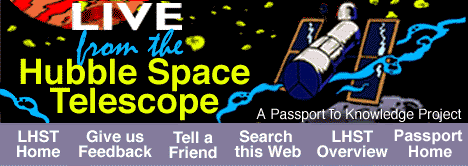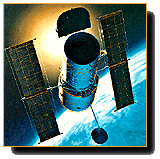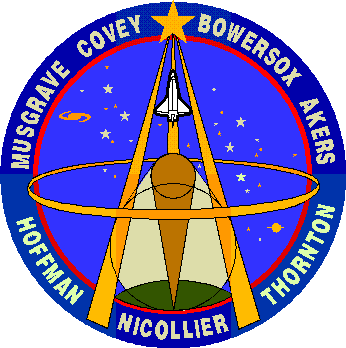

Long before mankind had the ability to go into space, astronomers dreamed of placing a telescope above Earth's obscuring atmosphere. An observatory in space was proposed in 1923 by the German scientist Hermann Oberth, whose work inspired rocket pioneer Dr. Wernher von Braun's interest in space travel. Scientific instruments installed on early rockets, balloons, and satellites in the late 1940s through the early 1960s produced enough exciting scientific revelations to hint at how much remained to be discovered.
In 1962, just four years after NASA was established, a National Academy of Sciences study group recommended the development of a large space telescope as a long-range goal of the fledgling space program. The recommendation was repeated by similar groups in 1965 and 1969.
The first two successful NASA satellites designed for observing the stars were launched in 1968 and in 1972. These Orbiting Astronomical Observatories produced a wealth of information, and support for an even larger, more powerful optical space telescope grew. The approval of the Space Shuttle, with its capacity for manned delivery and servicing of large payloads, made the space telescope concept feasible. NASA selected a team of scientists in 1973 to establish the basic design of such a telescope and its instruments. An expanded group of 60 scientists from 38 institutions was formed to refine those recommendations in 1977. That same year Congress authorized funding for the project.
NASA assigned responsibility for design, development, and construction of the space telescope to the Marshall Space Flight Center in Huntsville, Alabama. Goddard Space Flight Center in Greenbelt, Maryland, was chosen to lead in the development of the scientific instruments and the ground control center. The European Space Agency got involved with the project in 1975.
Marshall selected two primary contractors to build the Hubble Space Telescope. Perkin-Elmer Corporation in Danbury, Connecticut, was chosen to develop the optical system and guidance sensors. Lockheed Missiles and Space Company of Sunnyvale, California, was selected to produce the protective outer shroud and the support systems for the telescope, as well as to assemble the finished product.
The European Space Agency agreed to furnish the solar arrays and one of the scientific instruments. Goddard scientists were selected to develop one instrument, and three of the others became the responsibility of scientists at major universities.

The Space Telescope Science Institute, on the campus of Johns Hopkins University in Baltimore, Maryland, was dedicated in 1983. It will perform the science planning for the telescope. Scientists there will select observing proposals from various astronomers, coordinate research, and generate the telescope's observing agenda. They will also archive and distribute results of the investigations. The institute is operated by the Association of Universities for Research in Astronomy and directed by Goddard.
In 1985 the Space Telescope Operations Control Center, located at Goddard, was established as the ground control facility for the telescope. The observing agenda from the Science Institute is translated into computer commands by the control center and relayed to the telescope. In turn, observation data is received at the center and translated into a format usable by the Science Institute. The control center also will monitor the health and safety of the satellite.
Construction and assembly of the space telescope was a painstaking process which spanned almost a decade. The precision-ground mirror was completed in 1981, and the optical assembly was delivered for integration into the satellite in 1984. The science instruments were delivered for testing at NASA in 1983. Assembly of the entire spacecraft was completed in 1985.
Launch of the Hubble Space Telescope was originally scheduled for 1986. It was delayed during the Space Shuttle redesign which followed the Challenger accident. Engineers used the interim period to subject the telescope to intensive testing and evaluation, assuring the greatest possible reliability.
The telescope was shipped from Lockheed in California to the Kennedy Space Center in Florida in October 1989. There, it was launched aboard the STS-31 mission of the Space Shuttle Discovery on April 24, 1990.

The focusing defect was due to spherical aberration, an optical distortion caused by an incorrectly shaped mirror. The mirror was too flat near the edge by about 1/50th the width of a human hair. Instead of being focused into a sharp point, light collected by the mirror was spread over a larger area in a fuzzy halo. Images of objects such as stars, planets and galaxies were blurred. However, on relatively bright objects, Hubble's cameras were still able to provide images far superior to any telescope on the ground.
Program and project management officials, working with the scientific community, developed a plan to take advantage of the telescope's instruments that were not affected by the aberration, such as ultraviolet and spectrographic observations.
During its first three years of operation, Hubble provided significant new information and discoveries about the universe, including astonishing images of supernova 1987A and a disk of cold gas fueling a black hole.
The mirror itself couldn't be fixed or changed; so the challenge facing NASA was to develop corrective optics for Hubble's instruments, much like eyeglasses or contact lenses correct human sight.
Although the task proved technically challenging, it was less difficult than it might have been because NASA had always planned to service the telescope. Engineers designed Hubble so astronauts could easily change failed parts or update the telescope with more advanced instruments. Instruments were designed like dresser drawers: they could be pulled out and replaced with others of the same size.
The two major instruments planned for installation, the Wide Field/Planetary Camera (WF/PC-II) and the Corrective Optics Space Telescope Axial Replacement (COSTAR), were designed to correct the aberration. WF/PC- II was designed so that the light reaching each of the instrument's four cameras was corrected by relay mirrors polished to a prescription compensating for the incorrect figure produced by Hubble's primary mirror.
COSTAR routed properly focused light to three of Hubble's five instruments. Ball Corp. built Hubble's corrective optics for the Goddard Space Flight Center, Greenbelt, MD.
The seven astronauts selected to service Hubble practiced for nearly a year-and-a-half. They spent hundreds of hours practicing and learning the uses of more than 100 different servicing tools. This mission would be one of the most challenging missions NASA had ever attempted.


On December 2, 1993, the STS-61 crew launched on Space Shuttle Endeavour for an 11-day mission with a record five spacewalks planned. Watched by millions worldwide on live television, the astronauts endured long hours of challenging spacewalks to install instruments containing the corrective optics and replaced the telescope's solar arrays, gyroscopes, and other electronic components.
They installed WF/PC-II and replaced the High Speed Photometer with the COSTAR instrument. They also installed a new computer co-processor to upgrade the telescope's computer memory and processing speed, the Solar Array Drive Electronics unit and the Goddard High Resolution Spectrograph Redundancy Kit.
The crew completed everything it set out to do and the mission was declared a success. After five weeks of engineering check-out, optical alignment and instrument calibration, the confirmation of success came as the first images were received on the ground from the space telescope.
NASA Administrator Daniel Goldin was joined in announcing the successes by Dr. John Gibbons, Assistant to the President for Science and Technology, and Sen. Barbara Mikulski (D-MD), at a press conference at Goddard.
"This is phase two of a fabulous, two-part success story," Goldin said at the press conference. "The world watched in wonder last month as the astronauts performed an unprecedented and incredibly smooth series of space walks. Now, we see the real fruits of their work and that of the entire NASA team."
Not only has Hubble advanced science's understanding of the universe, it also is making direct contributions through a variety of technological spinoffs. During 1994 a new, non-surgical breast biopsy technique was developed using imaging Charge Coupled Devices, originally developed for Hubble's Imaging Spectrograph. This technology now enables doctors to precisely locate a suspicious lump in a woman's breast and use a needle, instead of a scalpel, to extract a sample of tissue for study.
The Hubble Space Telescope was designed to work on orbit for 15 years, providing an unparalleled observatory for astronomers well into the next century. To keep Hubble running smoothly, three additional servicing missions are planned, similar to but probably not as extensive as the first servicing mission in 1993.
During the next servicing mission, scheduled for February 1997, astronauts will install two new instruments -- the Space Telescope Imaging Spectrograph and the Near Infrared Camera and Multi-Object Spectrograph. The third servicing mission, scheduled for November 1999, will see the installation of the Hubble Advanced Camera for Exploration, which will greatly enhance the telescope's imaging capabilities.
Hubble's current cameras are showing us remarkable views of the very distant galaxies, but the light from more distant galaxies is shifted to infrared wavelengths by the expanding universe. Hubble's new camera, NICMOS, will be able to observe infrared light revealing the earliest stages of galaxy evolution.
The Near Infrared Camera and Multi-Object Spectrometer (NICMOS) will allow astronomers to use Hubble's exquisite detail to open a new "window" of the electromagnetic spectrum. Many secrets about the birth of stars, solar systems, and galaxies are available in Infrared (IR) light, which can penetrate interstellar dust that blocks visible light. Because NICMOS' advanced detectors must be kept cool to work best, they are contained in a dewer (similar to a thermos bottle), chilled with solid nitrogen to -351 degrees Fahrenheit (70 degrees Kelvin).
The light emitted by stars and gas orbiting the center of a galaxy appears redder when moving away from us, bluer when coming toward us. When looking for this signature of a black hole, current spectrograph measurements (circles) could only be made one at a time. The new instrument will measure 500 different points in a single observation -- making Hubble a faster black hole hunter.

![]()